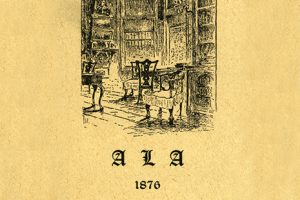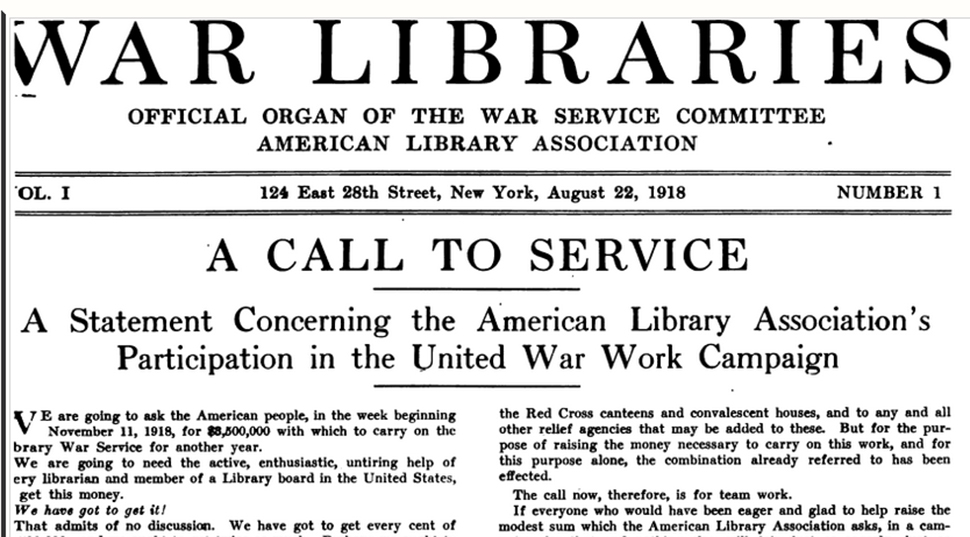
“Decent, but not too highbrow.” That’s how one volunteer described the kind of fiction he and his colleagues solicited from their Hibbing, Minnesota, neighbors for the second of three book collection campaigns the American Library Association (ALA) sponsored for servicemen during World War I.
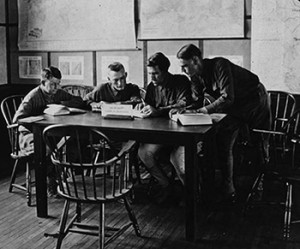
The ALA established its Library War Service in 1917 to provide books and library services to US soldiers and sailors both in training at home and serving in Europe. This second book drive in early 1918 generated 3 million books, many going overseas, others ending up on the shelves of 36 training-camp libraries erected through Carnegie Corporation funding and managed by ALA volunteers across the country. To help public librarians with the campaign, an ad hoc ALA Library War Council issued a pamphlet titled How to Conduct the Campaign for Libraries for Our Soldiers and Sailors.
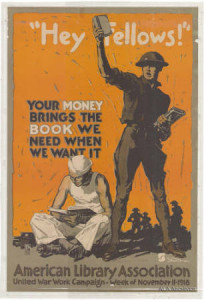
The collecting activities ALA monitored demonstrate some of the same professional creativity we see among libraries today.
- The Millville (N.J.) Public Library sponsored a movie benefit. Each person buying a ticket was also asked to bring a book for soldiers. The library sold out four performances and collected several hundred books.
- Boy Scouts in Milwaukee commandeered wheelbarrows and baby carriages to move books they collected door-to-door.
- The St. Louis Public Library hosted numerous events in the main library and branches across town. The Crunden branch conducted a dance in the reading room, where a Filipino orchestra whose members wore native costumes played music from behind the circulation desk. Dancers paid an admission fee (which ALA used to buy books for the campaign) or donated a book. The Carondelet branch hosted a chaplain from a nearby training camp to lecture on camp life and the soldier’s need for reading materials.
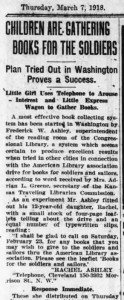
For publicity value, however, few outdid 12-year-old Rachel Ashley, daughter of Frederick William Ashley, who was the superintendent of the Library of Congress main reading room at the time. In February 1918, Rachel dropped off ALA leaflets at homes in her Washington, D.C., neighborhood, to which she attached her phone number and slips noting: “I shall be glad to call on Saturday, February 23, for any books that you may wish to give to the soldiers and sailors thru the American Library Association.” Within an hour of returning home she began getting calls. That Saturday morning she and two friends pulled a child’s “express wagon” from house to house, and by noon they collected 121 books. “Little Ashley’s example is to be followed by hundreds of other school girls,” ALA’s War Library Bulletin noted.
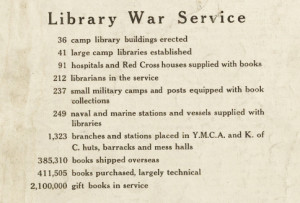
During the war, tens of thousands of servicemen spent much of their free time reading in those camp libraries and near the European battlefronts. By poring over “decent but not too highbrow” fiction, many improved their literary skills beyond the merely functional. The affinity they developed for these services often carried over into postwar use and support of public libraries. The definitive work on this subject is Arthur P. Young’s Books for Sammies: The American Library Association and World War I (Pittsburgh: Beta Phi Mu, 1981).
ALA’s participation in the nation’s World War I effort served as a capstone to the public library movement that was made possible during the previous 20 years because of the philanthropy of Andrew Carnegie and other benefactors, as well as the professional practices ALA had fostered and libraries had adopted. Combined, they all helped to make the public library an essential institution in local American communities, a position it has never relinquished.
Note: This post is part of a six-part series on the American Library Association’s proudest moments, written for ALA’s 140th anniversary celebration.
Part 1: Present at the Creation
Part 2: The Library War Service

 WAYNE A. WIEGAND is F. William Summers professor of library and information studies emeritus at Florida State University and author of Part of Our Lives: A People’s History of the American Public Library (Oxford, 2015). Contact him at
WAYNE A. WIEGAND is F. William Summers professor of library and information studies emeritus at Florida State University and author of Part of Our Lives: A People’s History of the American Public Library (Oxford, 2015). Contact him at 